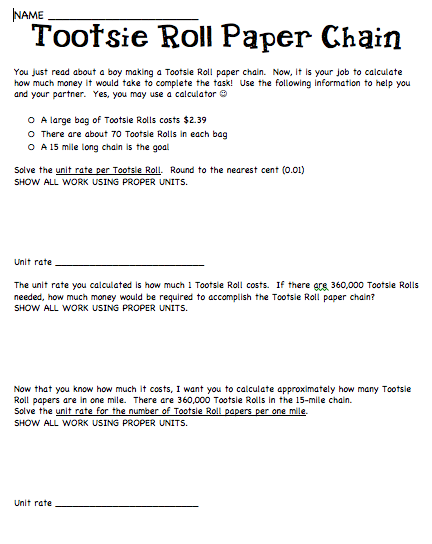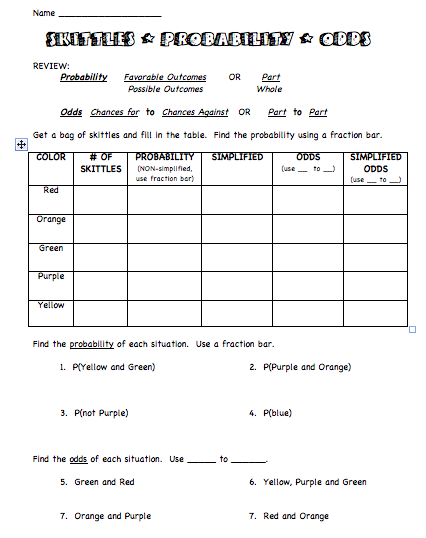Dan Phillips is a carpenter in Texas that builds houses out of recycled and salvaged materials. The link below has more information about his projects and shows some great examples of his work.
http://www.phoenixcommotion.com/
"The important thing is not to stop questioning. Curiosity has its own reason for existing." -–--Albert Einstein
Thursday, March 29, 2012
March 29
Topic Time Warp Video
Question: After the video
Question: After the video
Wednesday, March 28, 2012
Tuesday, March 27, 2012
March 27
Topic: Unbalanced vs Balanced
Question: Wait for the bell to ring
Question: Wait for the bell to ring
Monday, March 26, 2012
Unit Rates - Tootsie Roll Paper Chain Activity
In 2010 I found an article in the Lincoln Journal Star about a student that was trying to break the world record for the longest tootsie roll paper chain. His goal was 15 miles. After I read the article, it made me wonder what it would take to accomplish this goal. How long would it take? How many tootsie rolls would it take? How much money would he need? Then, I made a worksheet that asked those questions and many more, but the questions were set up so that students had to solve for unit rates.
Worksheet example.
Tootsie Roll
After reading the article as a class and completing the worksheet, I handed out tootsie rolls for students to eat. Immediately, students started stapling wrappers to make their own Tootsie Roll paper chain. After 3 years of doing the activity in class and collecting wrappers from students and my family, I have a pile that I stuff away and take out during this unit. This year my students want to measure the chain, which we still need to do, but knowing that they want to bring in wrappers from home lets me know this activity is fun and goes beyond just learning math.
Worksheet example.
Tootsie Roll
After reading the article as a class and completing the worksheet, I handed out tootsie rolls for students to eat. Immediately, students started stapling wrappers to make their own Tootsie Roll paper chain. After 3 years of doing the activity in class and collecting wrappers from students and my family, I have a pile that I stuff away and take out during this unit. This year my students want to measure the chain, which we still need to do, but knowing that they want to bring in wrappers from home lets me know this activity is fun and goes beyond just learning math.
| Stapling the wrappers. |
| The pile is about twice the size after stapling the wrappers from the zip-lock baggies. |
| Quick measure of what was stapled at the end of one class period. |
| 15 minutes worth of stapling. |
| I will add more pictures when we measure the entire chain. This is a small section. |
UPDATE!
| The mess before we organized it to measure it all out! |
| The students used a meter stick to measure and mark the wall with tape. |
| Some students were in charge of holding down the wrappers, while others went back and forth. |
| Fixing with staples, there were a few tears! |
| Math work on the board |
After going through all the math and converting into inches and feet, we found that the chain was 659.4 inches or 54.95 feet! Now I need to figure out a way to store all the wrappers!
Probability and Odds - Skittles Activity
Use skittles to have students display their probability and odds knowledge. Each student gets a small baggie of skittles (1/4 cup). After the initial info is collected (number of each color) students can eat their skittles. In order to make sure students are accountable for their work, have students trade papers to check one another's work.
Supplies...lots of skittles
Students at work.
Worksheet example.
| QR code links to a math video with Abbot and Costello. |
Capture/Recapture - Proportions Math Activity
Use proportions to show capture/recapture and how it's used in real-life.
Go over the directions and example as a class.
Once the activity has been explained, students can get their supplies.
Supplies needed for each group (groups of 2 works great):
1. Small paper bag filled with 2 dixie cups worth regular (orange) Goldfish Crackers
2. Dixie cup filled with pretzel Goldfish (or colored Goldfish without the orange crackers)
Students then follow along with the worksheet, which has step-by-step directions.
Students at work during the activity.
Worksheet examples:
Go over the directions and example as a class.
 |
| Go over the deer example together as a class. Students can show work in the blank space to the left. |
Supplies needed for each group (groups of 2 works great):
1. Small paper bag filled with 2 dixie cups worth regular (orange) Goldfish Crackers
2. Dixie cup filled with pretzel Goldfish (or colored Goldfish without the orange crackers)
Students then follow along with the worksheet, which has step-by-step directions.
 |
| 5 Trials is best. I used 3 because of the time factor. |
| First students count how many pretzel Goldfish or colorful Goldfish are in the dixie cup. The colorful fish or pretzel fish represent the tagged fish in the population. |
| After students recapture using the same dixie cup, they count how many tagged fish there are and how many total fish were recaptured. Then, they record their results in the table. |
 |
| This student had 27 colorful fish in the dixie cup, which is recorded at the top. The table represents the number of tagged and the total number of fish recaptured in each dixie cup scoop. |
 |
| Worksheet used to determine how close the estimations were compared to the actual population. This student's estimations were off by 8 fish. I've had perfect estimations before. |
Another student example:
Energy Poster and QR Codes
Use QR codes to incorporate technology into posters. Instead of writing out conversions, have students create QR codes and glue them to the poster or labbook. Students enjoyed sharing posters and exploring other classes ideas after they were all taped to the wall.
Students typed their conversions in google docs (to save, just in case they needed a hard copy) and then copied and pasted each step of their conversion process using a QR code site.
This site works well: KAWAY QR Code Generator
http://qrcode.kaywa.com/
Students typed their conversions in google docs (to save, just in case they needed a hard copy) and then copied and pasted each step of their conversion process using a QR code site.
This site works well: KAWAY QR Code Generator
http://qrcode.kaywa.com/
| What pops up on the phone after reading the QR code. |
| Scanning the QR code. |
| Exploring other class posters. |
| Groups of 2 or 3 shared Ipods or Ipads since not all students have access to the technology. |
| Students made posters or lapbooks with mini books or foldables inside. |
| Another view of the screen after scanning. |
| Using manure as alternative energy! |
| Sign posted to inform students that walk down the hall. |
Subscribe to:
Posts (Atom)




